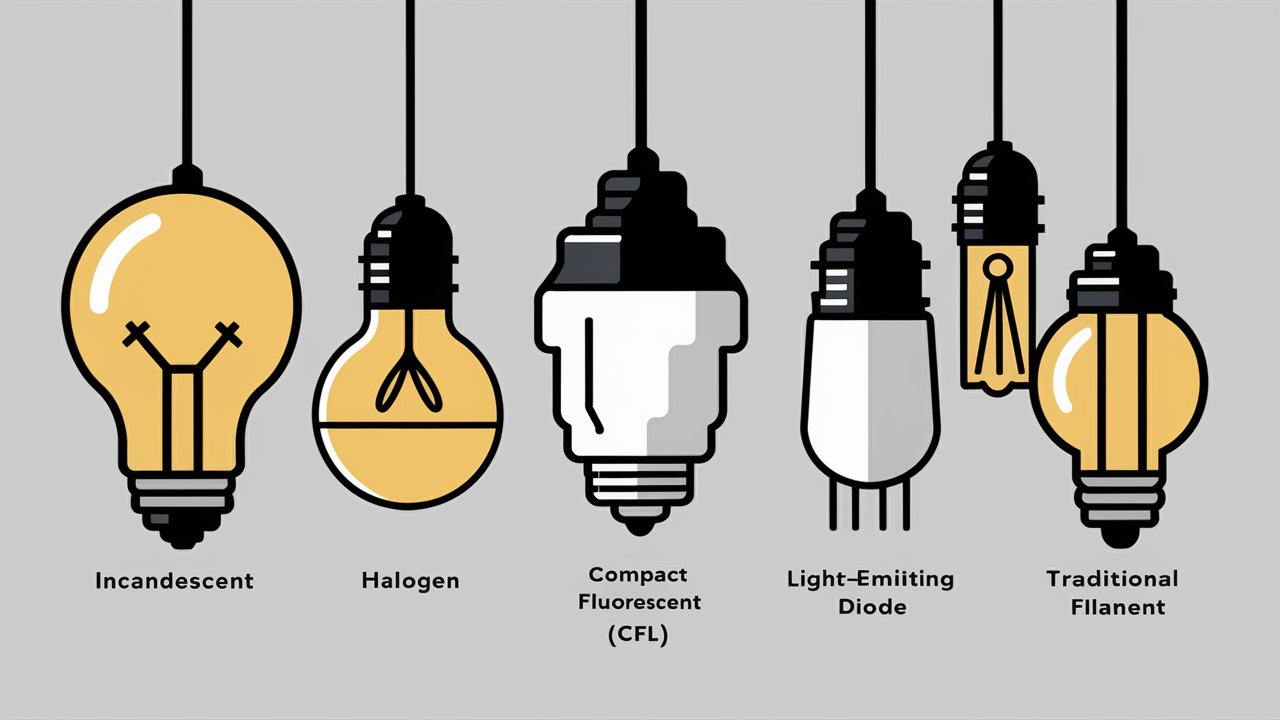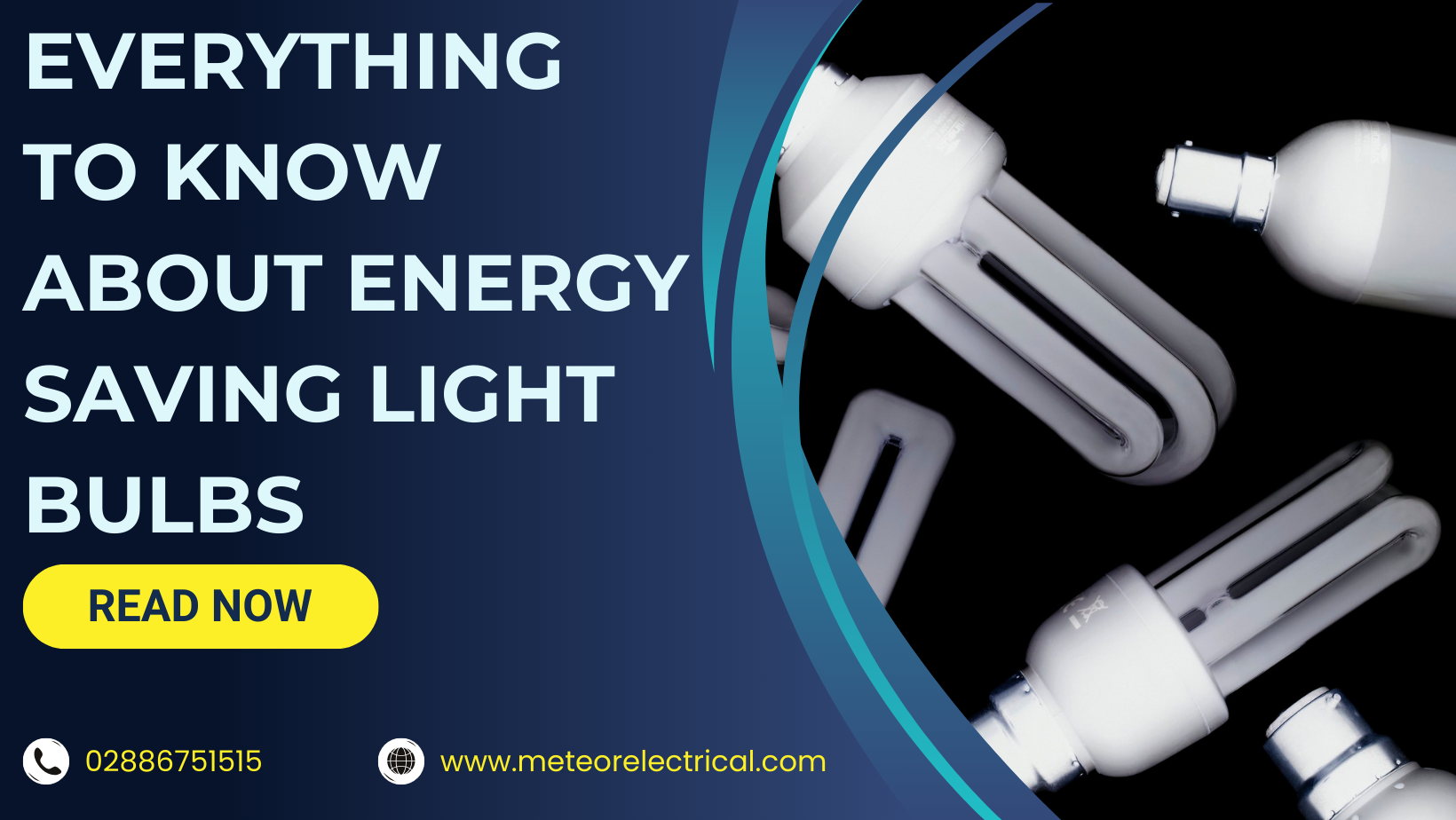Energy Saving Light Bulbs: The Bright Choice for Your Home

Are you tired of high electricity bills and looking for an eco-friendly lighting solution? Energy-saving light bulbs are the answer. Not only do they cut down your energy costs, but they also help protect the environment. At Meteor Electrical, we understand the importance of efficient lighting. This guide will illuminate the benefits of switching to energy-saving bulbs and help you choose the best options.
With popular searches like "brightest light in the world" and "halogen vs LED," people are eager to find efficient lighting. We'll cover the differences between LED and CFL bulbs, how much energy they save, and why they're a smart choice for your home. Let’s shed light on why energy-saving bulbs are the bright choice for your home and the planet.
Why Switch to Energy-Saving Light Bulbs?
Are you ready to cut down on your energy bills and reduce your carbon footprint? Switching to energy saving light bulbs is a simple yet powerful way to achieve both. Energy-saving bulbs, such as LED and CFL, are designed to use significantly less electricity than traditional incandescent bulbs. This means you can enjoy the same level of brightness while consuming up to 90% less energy. Not only will you save money, but you'll also be contributing to a greener planet (Energy.gov).
Energy-saving light bulbs last longer, reducing the need for frequent replacements. This longevity makes them a cost-effective choice in the long run. Whether looking for the brightest light in the world or just a reliable light for everyday use, energy-saving options are available to meet your needs (Energy Saving Trust).
How Do Energy-Saving Light Bulbs Work?

The secret behind energy saving light bulbs' efficiency lies in their advanced technology. Unlike traditional incandescent bulbs, which use a filament that heats up and emits light, energy-saving bulbs employ different mechanisms.
LED Light Bulbs (Light Emitting Diodes)
LEDs produce light by passing an electrical current through a semiconductor. This process is highly efficient, converting most energy into light rather than heat. LED bulbs are known for their durability and can last up to 25 times longer than incandescent bulbs (HowStuffWorks).
CFL Light Bulbs (Compact Fluorescent Lamps)
CFLs use a different technology. They contain a small amount of mercury vapour that emits ultraviolet light when electrified. This UV light then interacts with a fluorescent coating inside the bulb, producing visible light. CFLs are also much more efficient than traditional bulbs and can last up to 10 times longer.
By choosing energy saving light bulbs, you save on energy costs and benefit from longer-lasting higher-quality lighting. Whether you’re comparing halogen vs. LED or looking for specific options like the brightest light on earth, energy-saving bulbs offer superior performance and efficiency.
Bayonet Light Bulbs: A Cost-Effective Choice
Energy-saving bayonet light bulbs are recognised for their rounded shape and compact size. They are one of the cheapest energy-saving options available and are known for their efficiency and durability.
The Evolution of Light Bulbs
Understanding the history of light bulbs helps explain the growing demand for energy-saving options:
Incandescent Bulbs: Invented over 100 years ago, incandescent bulbs have become a symbol of inefficiency. They convert only 5-10% of electricity into light, with the rest wasted as heat. Despite their warm glow, incandescent bulbs are highly energy-inefficient and shortlived (Energy.gov).
Halogen Bulbs: A slight improvement over incandescent bulbs, halogens use filament technology that produces a brighter light and lasts longer. However, they are still less efficient than modern alternatives. Halogen bulbs are known for their high heat output and are commonly used in spotlights and floodlights.

Compact Fluorescent Lamps (CFLs): These bulbs marked the first significant step toward energy efficiency. CFLs use 70-80% less electricity than incandescent bulbs and last much longer. They work by passing an electric current through a tube containing gases, which emit ultraviolet light that excites a fluorescent coating inside the tube to produce visible light (Environmental Protection Agency).
LED Light Bulbs: The current pinnacle of energy-saving technology, LEDs provide maximum efficiency and longevity. They use semiconductors to convert electricity into light, resulting in minimal energy waste and a much longer lifespan compared to incandescent and halogen bulbs. LEDs are available in various shapes, sizes, and colour temperatures, making them versatile for different applications.
Measuring Energy Efficiency: Lumens vs. Watts
Traditionally, light bulbs were measured in watts, indicating their energy consumption. However, with the advent of energy-efficient bulbs, lumens—a measure of brightness—have become more relevant. Here’s a comparison to help you understand the efficiency of different bulb types:
|
Type of Bulb |
200-300 Lumens |
300-500 Lumens |
500-700 Lumens |
700-1000 Lumens |
1000-1250 Lumens |
1250-2500 Lumens |
|
Incandescent |
25-30 watts |
40 watts |
60 watts |
75 watts |
120 watts |
150-250 watts |
|
Halogen |
18-25 watts |
35 watts |
50 watts |
65 watts |
100 watts |
125 watts |
|
CFL |
5-6 watts |
8 watts |
11 watts |
15 watts |
20 watts |
20-33 watts |
|
LED |
2-4 watts |
3-5 watts |
5-7 watts |
8-10 watts |
10-13 watts |
13-20 watts |
By switching to energy-saving bulbs like LEDs or CFLs, you can enjoy significant energy savings and reduce your electricity bills while maintaining the desired brightness level in your home. Explore the range of energy-saving bulbs at Meteor Electrical and make the smart choice for a brighter, more sustainable future.
Choosing the Best Energy-Saving Light Bulbs

When switching to energy-saving bulbs, consider the following factors to make the best choice for your needs:
Desired Brightness
Lumens measure a bulb's brightness, not watts. Check the lumens to find a bulb that meets your lighting requirements. For example, a 60-watt incandescent bulb is roughly equivalent to an 800-lumen LED bulb (Energy Star).
Type of Bulb
Decide between CFL and LED based on your needs. LEDs are generally more efficient and have a longer lifespan, while CFLs can be a more affordable option initially.
Functionality
Some bulbs provide immediate brightness, while others, like CFLs, may take a moment to warm up. LEDs typically offer instant full brightness, making them suitable for areas where immediate light is essential.
Energy Consumption
LED bulbs use significantly less energy than CFLs or incandescent bulbs, making them the most cost-effective choice in the long run.
Lifespan
LEDs typically last longer than CFLs, offering better value over time. An LED bulb can last up to 50,000 hours, whereas a CFL may last around 8,000 hours (Energy Star).
Safety
LEDs are mercury-free, unlike CFLs, making them safer for your home and the environment. Proper disposal of CFLs is crucial due to their mercury content.
How to Handle and Dispose of Energy-Saving Light Bulbs

Proper disposal of energy saving light bulbs is crucial due to the presence of potentially harmful materials. Here’s how you can dispose of your old lights.
Removing a Broken LED Bulb
Treat broken LED bulbs as hazardous waste. Wear a mask and gloves, and clean the area thoroughly. Use a double bag to dispose of the fragments, avoiding direct contact. Contact your local hazardous waste site for disposal instructions, as some areas require you to bring waste to a collection site.
Removing a Broken CFL Bulb
CFL bulbs contain mercury vapour, which is hazardous. If a CFL bulb breaks, evacuate the room immediately to avoid inhaling mercury. Turn off devices that move air and ventilate the room for 5-10 minutes. Clean up the fragments carefully without using a vacuum, and place them in a sealable container. Contact local hazardous waste outlets for proper disposal instructions.
What Are Energy-Saving LED Light Bulbs?
Energy-saving LED light bulbs, or light-emitting diode bulbs, are highly efficient and robust lighting solutions. Initially used in electronics and pen lights, LEDs have evolved significantly. Modern applications include indoor string lighting, Christmas lights, and battery-powered products like headlamps and flashlights (Energy.gov).
Manufacturers now produce LEDs in clusters, sometimes with up to 180 bulbs per cluster, encased in diffuser lenses to spread light widely. This innovation has made LEDs one of the best energy saving light bulbs in the UK. They come with standard base fixtures suitable for domestic use, and the diffuser lens helps distribute light evenly.
A key feature of LED bulbs is their directional light emission, which suits recessed and under-cabinet lighting but not table lamps. Modern LEDs overcome this with diffuser lenses and reflectors, dispersing light similarly to incandescent bulbs.
While LEDs offer significant energy savings, their high upfront and production costs remain challenges. However, ongoing research is making LEDs more efficient and affordable. For additional energy savings, consider switching to smart lighting solutions.
Curious to learn more about energy-saving bulbs? Here’s a helpful video.
Credit: Energy Saving Trust
Benefits of Energy-Saving LED Light Bulbs
Long Lifespan: LED bulbs can last up to 50,000 hours, significantly reducing the need for frequent replacements. This longevity makes them a cost-effective option over time (CNET).
Durability: LEDs are more durable as they do not have a filament that can break. This makes them more resistant to shock and vibration, ideal for various environments.
Low Heat Output: LEDs, especially low wattage bulbs produce minimal heat, keeping your home cooler and reducing air conditioning costs. This also reduces the risk of burns or fires compared to traditional bulbs.

High Efficiency: LEDs use less electricity than incandescent and CFL bulbs, offering substantial energy savings and lower electricity bills.
Environmental Impact: LEDs are free from hazardous materials like mercury, which are present in CFLs. This makes them safer and more environmentally friendly for lighting your home.
Switching to energy saving light bulbs like LEDs benefits your wallet and contributes to a greener planet. Explore the range of energy-saving bulbs at Meteor Electrical and make a smart investment in your home today.
Do Energy-Efficient Light Bulbs Save Money?
Switching to energy-efficient light bulbs results in significant financial savings. Here’s how much you can save annually per bulb:
- Replacing a 100-watt incandescent bulb with a 1,000-lumen LED bulb saves around £13.
- Replacing a 75-watt incandescent bulb with an 825-lumen LED bulb saves up to £8.
- Replacing a 60-watt incandescent bulb with a 660-lumen LED bulb saves £6.
- Replacing a 40-watt incandescent bulb with a 440-lumen LED bulb saves £4 (Energy Alliance Group).
These figures highlight the substantial cost benefits of switching from traditional incandescent bulbs to energy-saving alternatives like LEDs.
Which Are the Best Energy-Saving Light Bulbs on the Market?

Discover some of the best energy saving light bulbs available at Meteor Electrical. Our Kosnic range features top-tier energy-saving options. Low-wattage bulbs, ranging from 3 to 15 watts, offer substantial energy savings. Here are some standout products from Kosnic:
Kosnic 9W Energy-Saving Bayonet Light Bulbs in Warm White
This 9W bulb, Kosnic’s most popular, offers a warm white light perfect for domestic use. It reduces energy consumption by 85% compared to traditional bulbs. Despite its high efficiency, it costs just £2.87, making it one of the most affordable energy-saving options.
Kosnic 4.5W Warm White Lamp
With an intensity of 340 lumens, this high-brightness lamp suits both household and hospitality settings. It has a lifespan of over 30,000 hours, offering significant savings on replacement costs.
Kosnic 26W Cool White Compact Fluorescent Lamp
Ideal for commercial environments, this 26W fluorescent lamp is energy-efficient and cost-effective. It provides a uniform light spread, making it perfect for office spaces and retail areas.
Kosnic 4W Bayonet Cap Candle Bulb
This 4W candle bulb delivers 100 lumens per watt, offering a warm white light ideal for household applications. It's perfect for task lighting and creating an inviting living space, all at a budget-friendly price.
Conclusion
Switching to energy saving light bulbs is a smart and sustainable choice. LED bulbs, with their long lifespan, high efficiency, and low heat output, are the best option for reducing energy consumption and lowering your electricity bills. Whether you're looking for bright and durable lighting solutions or want to contribute to a greener planet, energy-saving bulbs from Meteor Electrical are the perfect choice. Explore our extensive range of LED light bulbs and start saving energy today.
For more insights on energy-efficient lighting and other electrical solutions, visit Meteor Electrical or contact us directly at [email protected]. Your journey to a brighter, more energy-efficient home begins with the right light bulb.
FAQ
1. What are the benefits of using energy saving light bulbs?
Energy-saving light bulbs, especially LEDs, reduce energy consumption, lower electricity bills, and have a longer lifespan compared to incandescent and halogen bulbs. They also produce less heat, making them safer and more environmentally friendly.
2. How much can I save by switching to LED light bulbs?
Switching to LED light bulbs can save you approximately £13 per bulb per year when replacing a 100-watt incandescent bulb. The exact savings depend on the bulb's wattage and usage, but LEDs generally offer significant cost reductions.
3. Are LED light bulbs better than CFLs?
Yes, LED light bulbs are more energy-efficient, have a longer lifespan, and do not contain hazardous materials like mercury, which is found in CFLs. LEDs also provide instant brightness and are more durable.
4. How do I choose the right LED light bulb?
Consider the desired brightness (measured in lumens), the bulb's wattage, the type of fixture, and the color temperature (warm or cool white) to suit your specific needs. For detailed guidance, visit Meteor Electrical's LED bulbs range.
5. Can LED light bulbs be used with dimmer switches?
Yes, many LED light bulbs are compatible with dimmer switches. However, it's important to check the bulb's specifications to ensure compatibility. Look for dimmable LEDs for the best performance.
6. How do I dispose of old energy saving light bulbs?
LED light bulbs can be recycled at designated recycling centres. For CFLs, handle them carefully due to the mercury content and follow local hazardous waste disposal guidelines.
7. What are the common styles of LED light bulbs?
Common styles include omnidirectional or diffused bulbs, dimmable globe bulbs, pin-base track lighting bulbs, and tube light LEDs. Each style is designed for specific lighting needs and applications.

